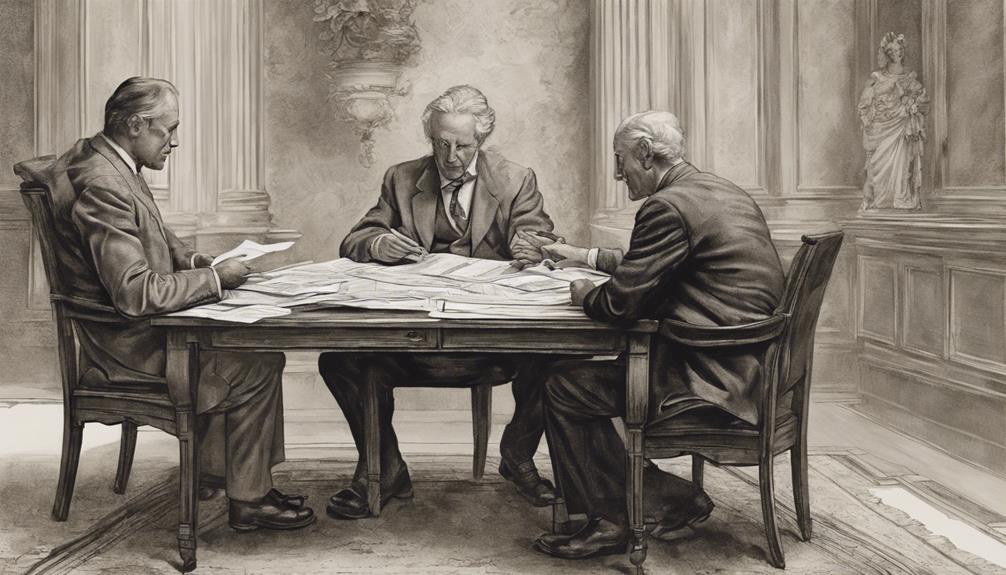Starting the process of divorce in California is like trying to find your way through a complicated maze, where each turn presents a new obstacle to conquer. As we dig deeper into this complex process, we discover numerous steps and requirements that require careful attention and patience.
Understanding the residency criteria and initial petition filing are just the tip of the iceberg, leaving us wondering about the intricacies of serving divorce papers and negotiating settlements. Stay with us as we unravel the complexities of finalizing the divorce process and shedding light on the path ahead.
Key Takeaways
- Meeting residency requirements is crucial for starting the divorce process smoothly.
- Properly completing and serving divorce papers is necessary for legal progression.
- Negotiating settlements on custody, support, and assets is vital for agreement.
- Finalize the divorce by submitting all required documents and completing the 6-month waiting period.
Residency Requirement for Divorce in California
To file for divorce in California, we must ensure that at least one spouse meets the residency requirement by having been a state resident for a minimum of 6 months. This is a crucial step in the divorce process as failing to meet this requirement can lead to delays or complications. Additionally, the spouse filing for divorce needs to have resided in the county where they plan to file for at least 3 months. It's essential to carefully consider these residency requirements before initiating any legal proceedings to ensure a smoother process.
If the residency requirements aren't met, there are alternatives such as filing for legal separation instead of divorce. Legal separation in California follows a similar process to divorce but doesn't terminate the marriage. This can be a viable option for couples who haven't yet met the residency requirements but still wish to legally formalize their separation. Understanding the residency requirements for divorce in California is fundamental to navigating the legal process effectively.
Filing the Initial Divorce Petition

When filing the initial divorce petition in California, we must submit Form FL-100 to the court, detailing essential information such as the marriage date, separation date, children involved, and desired outcomes. This step marks the official beginning of the California Divorce process, indicating the intent to dissolve the marriage. It is crucial to provide accurate information in the divorce papers to ensure a smooth legal process. Here is a table summarizing key points for filing the initial divorce petition:
| Key Points | Details |
|---|---|
| Form Required | FL-100 |
| Information Needed | Marriage date, separation date, children, desired outcomes |
| Filing Fee | $435 to $450 (may be waived in certain circumstances) |
| Purpose | Initiates the divorce process and informs the court of intentions |
| Important Consideration | Accuracy and completeness are essential for a successful filing |
Starting a divorce in California involves gathering financial information, understanding community property laws, and potentially discussing child custody arrangements. Seeking legal advice can be beneficial to navigate this complex process effectively.
Serving Divorce Papers to Your Spouse
Serving divorce papers to your spouse is a crucial step in the legal process of divorce in California. It's a legal requirement to provide formal notice of the California divorce to your spouse. This can be accomplished through various methods, such as using a professional process server or having someone over 18 years old deliver the papers. Alternatively, if both parties are on good terms, the papers can be served via mail.
Acknowledgment of service may be necessary to confirm that your spouse has received the divorce papers. This acknowledgment serves as proof that your spouse has been formally notified about the marital dissolution process. Ensuring that your spouse is properly served with the divorce papers is essential for moving forward with the California divorce proceedings.
Whether through a professional process server or mail service, spouse notification is a critical part of initiating the divorce process in California.
Negotiating Settlements and Agreements

As we navigate through the intricate process of divorce in California, the next crucial step involves engaging in negotiations to reach settlements and agreements that address key aspects such as child custody, spousal support, and asset division. When negotiating settlements and agreements during a divorce, parties should consider the following:
- Child Custody Arrangements: Discussing and deciding on the best custody arrangement for any children involved is paramount.
- Spousal Support Agreements: Determining the terms of spousal support, if applicable, is crucial for financial stability post-divorce.
- Asset Division: Fairly dividing shared assets, including property and finances, is a significant part of the negotiation process.
- Mediation, Collaborative Divorce, or Legal Representation: Choosing the appropriate method to facilitate negotiations is essential for a smoother process.
- Property Distribution and Financial Support: Establishing terms for property distribution and financial support is vital for a successful settlement that can lead to an uncontested divorce.
Finalizing the Divorce Process
Finalizing the divorce process in California involves submitting all necessary final paperwork to the court. This paperwork typically includes domestic, legal, and financial disclosures, along with any agreements reached regarding spousal support, child custody, and property division.
Before finalization, all issues must be resolved within the divorce case. Additionally, California imposes a mandatory 6-month waiting period from the date the divorce case is served to the finalization of the divorce.
It's crucial to adhere to California residency rules throughout the process to ensure the court maintains jurisdiction over the case. Once all requirements are met and the waiting period has passed, the court can officially grant the divorce, marking the end of the legal process.
This final step solidifies the dissolution of the marriage and allows both parties to move forward with their lives separately.
Frequently Asked Questions
What Is the Longest a Divorce Can Take in California?
The longest a divorce in California can take is typically around 1-2 years. Complex cases or disputes may extend the process. Factors like asset division, child custody battles, and spousal support disagreements can prolong proceedings.
Why Is My California Divorce Taking so Long?
We understand the frustration. Delays in California divorces stem from property, custody disputes, incomplete disclosures, and court schedules. Seeking legal guidance is crucial. Think of it as a complex puzzle; we'll help put the pieces together.
How Long Does It Take to Finalize a Divorce in California if Both Parties Agree?
Finalizing a divorce in California when both parties agree typically takes a minimum of 6 months. The mandatory waiting period is part of the process even with mutual agreement. All issues must be resolved for finalization.
How Long Is the Waiting Period for Divorce in California?
We understand the waiting period for divorce in California is at least 6 months, starting when the case is filed. This time is vital for reflection and resolution. Once completed, finalizing the divorce involves submitting required documents.
Is the Process of Getting a Divorce Without Going to Court More Efficient in California?
Getting a stepbystep divorce without court in California can be a more efficient process. By utilizing methods like mediation, collaboration, or arbitration, couples can avoid the traditional court proceedings. This alternative approach not only saves time and money but also allows the couple to have more control over the outcome. Additionally, reducing the stress and conflict often associated with court battles can help both parties move forward more amicably.
Conclusion
As we navigate the complex journey of divorce in California, remember that patience and perseverance are key. From meeting residency requirements to finalizing agreements, each step brings us closer to closure.
By understanding the process and seeking support when needed, we can emerge stronger and ready for the next chapter. Stay informed, stay resilient, and remember that you aren't alone in this journey.
The path may be long, but the destination is worth it.










